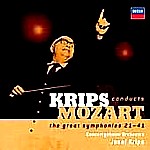It’s good to welcome this trim, 6-CD budget box of Mozart’s (mostly) mature symphonies, recorded in the early 1970s. But with today’s ears shaped by a new generation of conductors who favor smaller ensembles, transparent textures, fleet tempos, exaggerated contrasts, and what they believe to be period sonorities, this set can seem anachronistic, a throwback to an older era when tradition ruled with an often heavy hand. As such, many listeners will label Krips an “old fashioned” representative of the German-Austrian school. But tastes do change, and yesterday’s orthodoxy can return as tomorrow’s. Perhaps it’s best to think of this set as a “period” relic, an example of how Mozart was played in mid-century and therefore a source of historical interest, and for those with open minds and ears a source of musical pleasures often preferable to the ferocity to which these scores are sometimes subjected today.
In fact, the stereotype of Krips’ gemutlich Mozart has little evidence to support it here. Outer movements are often quite vigorous and forward moving, and slow movements generally flow–though Minuet movements often are hampered by a sense of squareness. In short, this is Big Band Mozart that continues to give pleasure.
The earlier shorter symphonies float by like a spring breeze, while the harbingers of the later Mozart’s boldness also are given their due. No. 25 and Nos. 29 through 34 possess abundant energy, at times restlessly dramatic, with a light comic-opera touch in the Andante of No. 25 and loving phrasing in No. 33. Nos. 35 and 36–the “Haffner” and “Linz”–are among the best in the set, reminiscent of renditions by Walter or Beecham. The “Prague”, No. 38, is powerful if lacking the fierceness and intensity of René Jacobs’ recent version, and No. 39 has a forward impetus shared by its fellows. The great G minor (No. 40) is slightly marred by a sluggish opening, but I like the way Krips brings out the contrast between the drama and the lyricism of the second subject. The “Jupiter”, No. 41, struck me as being the only misfire in the set, an earthbound performance wounded by an Andante cantabile that sounds more like an Adagio–and not a very cohesive one at that.
When Krips’ Mozart symphonies were released singly on LP they won a small but devoted following of audiophiles who reveled in the depth of the sound Philips captured from the Concertgebouw’s strings and from the ambience of the hall itself. Much of that has been preserved in these fine transfers, though the passage of time and the occasional swamping of the winds by the strings does compromise the desired transparency. All in all, this is a set to admire and enjoy. [7/2/2007]
































